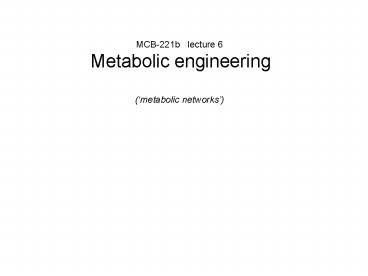Ways to improve microbial production - PowerPoint PPT Presentation
1 / 23
Title:
Ways to improve microbial production
Description:
Genes for biosynthetic enzymes can be amplified using multicopy plasmids ... citric acid output. Eukaryotes: compartmentation. Yield Optimization. in Aspergillus ... – PowerPoint PPT presentation
Number of Views:195
Avg rating:3.0/5.0
Title: Ways to improve microbial production
1
MCB-221b lecture 6 Metabolic
engineering (metabolic networks)
2
Feedback control
Inhibition/repression
C
D
E1
A
B
E
F
The first enzyme of the pathway is inhibited
when end products are in excess.
No overproduction allowed
3
Sequential feedback control and isoenzyme control
C
D
E2
E1
Sequential feedback control
A
B
E3
E1
E
F
Isoenzyme control
E1 and E1 are isoenzymes controlled be
different products
4
Bacteria do not normally overproduce amino
acidsbecause their biosynthetic pathways are
strictly regulated
- Strain selection (e.g. regulatory mutants,
auxotrophes) - Genes for biosynthetic enzymes can be amplified
using multicopy plasmids - Cloned genes can be made insensitive to
end-product repression or attenuation by point
mutations - Competing pathways can be inactivated by gene
disruption - Improvements of cultivation process could be made
5
Methionine Biosynthesis in E.coli
6
Substrate control modify fluxes
C
D
E1
A
B
E
F
For overproduction of P1, it breakdown catabolism
also needs to be controlled, as well as overall
growth (yield) and upstream fluxes into substrate
A. However, export of P1 (e.g. into the medium)
may alleviate feedback control!
7
Production of L-lysine
essential amino acid for most mammals
supplement cereal-based animal feed
0.5 of pure L-lysine is equivalent to 20 of
soybean meal
Current production 750,000 tons/year and
increasing by 7/year
other amino acids (methionin and
threonine/isoleucine) share the same synthetic
pathway
The yields usually obtained now are around 20 g
per 1 litre of the growth medium.
8
Reconstruction of the lysine metabolism
predicted genes are boxed (pathway of acetylated
intermediates in B. subtilis)
9
(No Transcript)
10
Corynebacterium glutamicum
Gram-positive, non-pathogenic, fast growing soil
bacterium
Pathways leading to amino acids are much simpler
in their regulation when compared to E.
Coli -- very few enzymes are feedback
controlled -- no isoenzymes detected -- genome
sequenced
Problems 1) vector system are far from ideal
(E.coli vectors will not work) 2)
Transformation rates are low
11
Corynebacterium glutamicumfirst, last and
branchpoint metabolic steps are logic targets
1970s Aspartate kinase. Feed bacteria with
non-metabolizable amino acid analogue. Bacteria
with feedback-insensitive enzymes will be
selectedas normal cells will be killed as their
pathways will be turned off permanently. 5-(ß-amin
oethyl)-L-cysteine (AEC) is an analogue of
L-lysine.
12
Corynebacterium glutamicumfor balancing
growth, stress resistance and lysine production,
central metabolic pathways have to be
modified.Specifically, 4 NADPH are needed.
13
Corynebacterium glutamicum fluxes
Normal conditions, no overproduction
14
Corynebacterium glutamicum fluxes
Without Aspartate kinase feedback inhibition,
35 molar overproduction
15
Corynebacterium glutamicum fluxes
Theoretical optimal fluxes, 75-80 molar
overproduction
16
Network rigidity which branchpoints are
important?
When P depends on both (1) and (2) ? dependent
network. Flux at both nodes must be balanced.
When P does not condense using products delivered
by (1) and (2) ? independent network. Flux at
either node (1) or (2) can be targeted.
17
Network rigidity which branchpoints are
important?
Flexible nodes affinity of enzymes for N are
similar for N?P and N?BWeakly rigid activity is
dominated by one enzymeRigid partitioning is
tightly controlled
18
Corynebacterium glutamicum fluxes
Theoretical optimal fluxes, 75-80 molar
overproduction
19
Network rigidity which branchpoints are
important?
or PDH knockdown (1 acitivity)
Pyr node Flexible. (Lysine is not limited by
pyr availability)G6P node Flexible. (molar
Lysine was not altered with gluconate (? PPP)
as substrate. NADPH not limiting.PEP
node rigid, best target for engineering.
20
However
21
(No Transcript)
22
(No Transcript)
23
Eukaryotescompartmentation Yield Optimization
in Aspergillus
Task Reroute flux in an optimal fashion e.g.,
maximize citric acid output































